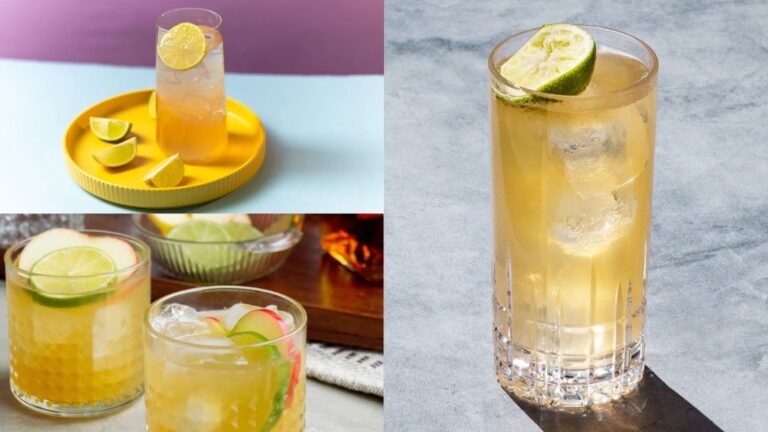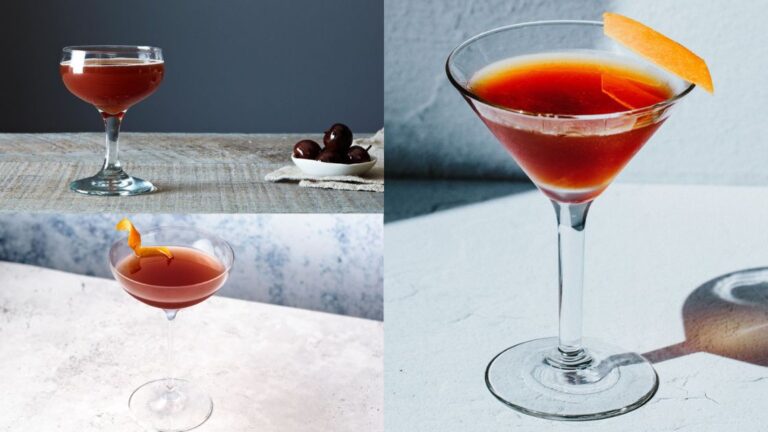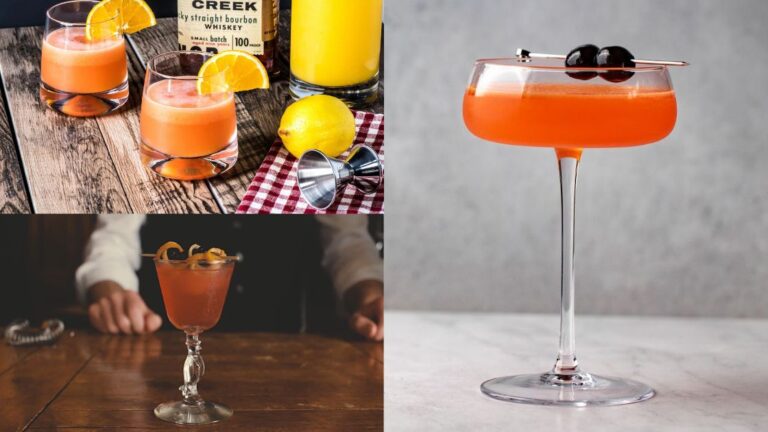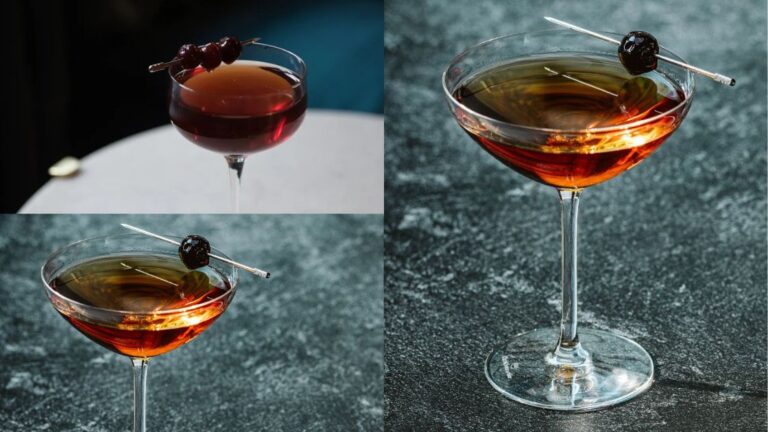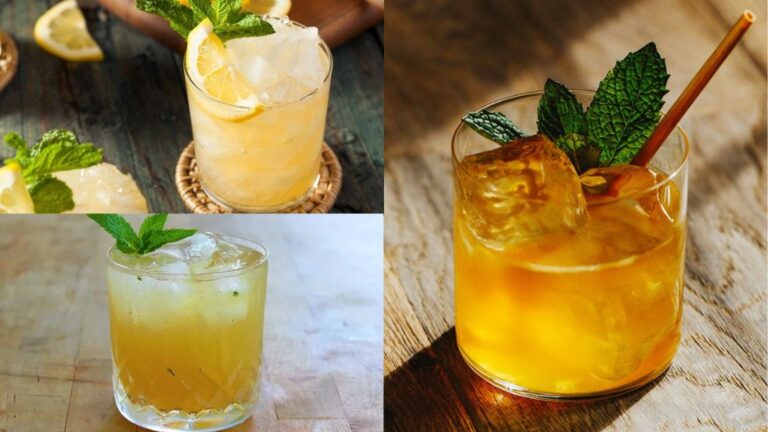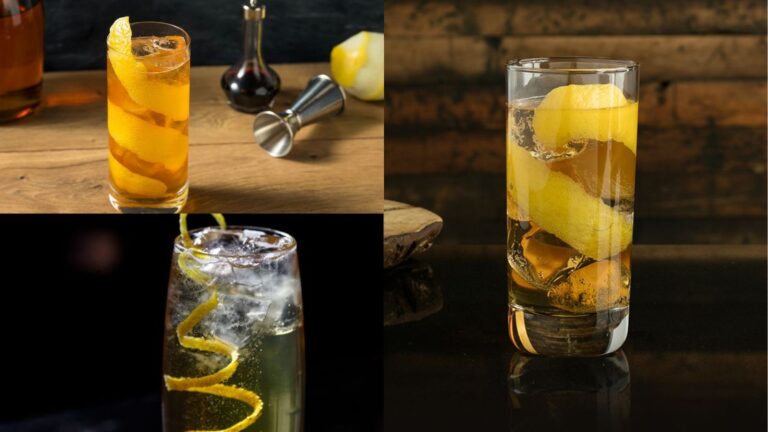Is Whiskey Stronger than Beer?
Yes Whiskey is much stronger than beer, with an alcohol by volume (ABV) of 40% to 50%, compared to beer’s typical 4% to 6%. A small 1.5-ounce shot of whiskey contains about the same amount of alcohol as a 12-ounce beer. This makes whiskey significantly more potent despite being consumed in smaller quantities.
Understanding Alcohol Content
Alcohol by Volume (ABV)
Alcohol by Volume, or ABV for short, is a way to know how much punch there is in your drink. It’s a big help when you’re trying to figure out how strong your craft brew or cocktail really is.
For your standard beer, ABV does a little dance between 4% and 7%, usually settling around 5%. So, when you pop open a 12-ounce can of 5% beer, you’re looking at about 0.6 ounces of pure alcohol in there.
Whiskey, that refined and fiery spirit, can pack a stronger wallop. It can legally be distilled up to 160 proof (which means a whopping 80% ABV), but has to chill out to no more than 62.5% before it gets comfy in its barrel home. Most of the whiskey you sip averages around 40% ABV.
Here’s a quick glance at how different drinks size up by their ABV:
| Beverage Type | Average ABV (%) |
|---|---|
| Beer | 5 |
| Wine | 12 |
| Whiskey | 40 |
Information drawn from Oak & Eden.
Impact of Beverage Type
What you drink does more than just tickle your taste buds—it can change how alcohol affects your body and mood. Research shows the total ethanol jammed in your system is the big player behind the trouble booze can cause, more so than the kind of drink you down (NCBI). But don’t underestimate spirits like whiskey, which can turn things rowdy with aggression and health woes.
Take it from the experts: spirits could lead to nasty stuff like cirrhosis, ischemic heart disease (a fancy name for heart trouble), and some types of cancer. Whiskey and its kin are also linked to higher rates of suicide compared to more laid-back choices like beer and wine.
Here’s the lowdown:
- Ethanol amount: This is the big deal-maker in alcohol-related issues.
- Type of beverage: Adds a little to the mix, but spirits often bring more drama to the table.
Getting to grips with ABV can steer you toward savvier sipping; compare how whiskey holds up against a frothy beer whiskey vs beer strength. If you’re thirsting for more, check out stories on different whiskeys—for instance, the face-off between whisky vs bourbon and the clash of scotch vs whiskey.
Risks and Health Effects
Health Risks of Alcohol
Drinking alcohol, whether it’s from whiskey or beer, comes with health concerns. Both have ethanol, the main type of alcohol that can mess with your body in more ways than one. If you keep at it, alcohol can mess up your liver, cause heart problems, and even some types of cancer. Plus, it can mess with your brain and lead to addiction, famously known as alcoholism (American Treatment Network).
It’s not about what you drink, but how much. Gulping down larger amounts of ethanol ups the chances of health fallout. So, keeping tabs on how much you’re knocking back is crucial to staying healthy.
Comparing Beer and Whiskey
When putting beer and whiskey side by side on the health risks plank, whiskey’s typically got more punch with its higher Alcohol by Volume (ABV). Whiskey’s got more booze packed into it, making it riskier if you drink the same volume as beer (American Treatment Network).
| Beverage | Average ABV (%) |
|---|---|
| Beer | 4-6 |
| Whiskey | 40-50 |
Although they both carry similar health concerns because of ethanol, whiskey and other hard liquors hit harder and faster. Why? Because whiskey can sneak up on you with its taste hiding the booze content, making it easy to overdo it. Plus, higher ABV items like whiskey can have a more noticeable impact on your behavior, like making you more aggressive compared to beer (NCBI).
If you’re curious about ABV and what it means for your drinking habits, check out our section on Beer vs. Whiskey ABV. Interested in different whiskey types? Look up our articles on whisky vs bourbon and scotch vs whiskey.
For ideas on drinking responsibly and how to drink whiskey safely, know how boozy each drink is and keep your consumption in check. Learn about the whiskey drunk effect and find tips to avoid going overboard and keep it moderate.
Production and Composition
Gettin’ the lowdown on how beer and whiskey are made helps you size up their kick. Beer and whiskey might both start with fermentation, but whiskey takes it up a notch with distillation.
Beer Production
Making beer starts by grabbing basics like malted barley, hops, and yeast. These simple things make a big difference in taste, smell, and what’s in your glass. Here’s a quick rundown of how beer comes to life:
- Malting: You soak barley grains, let ’em sprout, then dry them out. This turns barley’s starch into sugar.
- Mashing: Toss the malted barley in hot water, make a mash, and pull out the sugar, creating a liquid called wort.
- Boiling: Boil the wort and add hops for that bitter punch and aroma. This part also gives germs the boot.
- Fermentation: Cool down the wort and bring in the yeast. The yeast dances with sugars, turning them into alcohol and bubbles, to get beer.
- Maturation: Let beer chill out for a bit to get those flavors poppin’.
- Packaging: Filter, add bubbles, and pack the beer in bottles or cans, ready to go.
| Step | Description |
|---|---|
| Malting | Soak up and kickstart barley grains |
| Mashing | Blend with hot water to pull out sugars |
| Boiling | Hop addition and cleaning up the wort |
| Fermentation | Yeast turns sugars into brewski juice |
| Maturation | Chill time for tastiness |
| Packaging | Sifting, fizzing, and boxing up |
Beer usually has an ABV (alcohol by volume) of 3-12%, so it’s got nothin’ on whiskey’s punch. For a breakdown on ABV differences, see our piece on whiskey vs vodka.
Whiskey Distillation
Whiskey isn’t child’s play. It throws in distillation to ramp up strength and flavor. Here’s the lowdown on making whiskey:
- Mashing: Just like beer, grains like barley, corn, rye, or wheat are mashed up with hot water for sugar extraction.
- Fermentation: Add yeast to the mash, and it turns sugars to alcohol. You end up with a blend that has about 7-10% ABV.
- Distillation: Heat the mash. This process picks out the alcohol and cranks up the strength. By law, whiskey can hit a max of 160 proof, or 80% ABV.
- Aging: The alcohols hang out in wooden barrels, picking up cool flavors and tones while toning down the booze.
- Dilution: Before it’s sippable, whiskey is watered down to a mark—never below 40% ABV (80 proof) usually living between 40 – 62.5% ABV.
| Step | Description |
|---|---|
| Mashing | Sugar grabbin’ from grains |
| Fermentation | Yeasty fun makin’ alcohol (7-10% ABV) |
| Distillation | Strength-boosting the booze (up to 80% ABV) |
| Aging | Barrel resting for solid flavors |
| Dilution | Softening booze to 40-62.5% ABV for the shelf |
If you’re lookin’ for a deep dive into whiskey’s quirks and differences, try our posts on whisky vs whiskey and scotch vs whiskey.
Knowin’ how beer and whiskey make their debut helps decide what tickles your taste buds and packs the punch you want. Whether you hang with lighter beer or dig whiskey’s bold flavors and stronger kick, understanding the sides of the production story adds a layer to every sip.
Alcohol Content Comparison
Beer vs. Whiskey ABV
Hey, ever wondered why your shots of whiskey pack more punch than your beer sips? It’s all in the Alcohol by Volume, or ABV. Beer plays it safe with an ABV hanging between 4% and 6% (MurLarkey). Whiskey, on the other hand, proudly flexes an ABV around 40%, give or take, depending on which brand has caught your fancy.
| Beverage | ABV (%) |
|---|---|
| Beer | 4% – 6% |
| Whiskey | 40% – 62.5% |
Whiskey’s boozy prowess goes from a subtle 7% during its early days of brewing to an eye-watering 80% post-distillation. But the final act in the bottle? It mellows out to sit at a respectable 40%-62.5% (Oak & Eden).
Effects of ABV on Consumption
So what’s the deal with ABV’s effect on how much you guzzle before feeling the buzz? With its higher ABV, whiskey asks for moderation — smaller sips, less volume. In the beer corner, you might find yourself refilling the glass more often. If you’re wise, knowing this helps you avoid that pesky hangover and make smart choices about your drinks.
Let’s not forget the villain of the tale: ethanol. No matter the tasty form you choose, the amount of alcohol you knock back matters more for your health than whether it came from a barrel or a bottle (NCBI).
Craving more whiskey wisdom? Check out fun reads about whisky with water, whisky vs bourbon, or get really niche with jack daniels bourbon.
Individual Factors
Thinking about how whiskey stacks up against beer in the booze department, it’s all about you — your weight, how quick or slow you burn calories, how used to alcohol you are, and how you personally react. Get a grip on these aspects, and you’ll be a pro at knowing just what’s right for you.
Body Weight and Metabolism
The numbers on the scale and how revved up your internal engine is can change the way boozeness hits you. If you’re heavier, you’ve got more H2O in your system to water down the ethanol, chillin’ that buzz a bit. On the flip side, if you’re lighter, the kick comes faster and harder.
Metabolism is the party planner here. Some folks break down alcohol like it’s a race, making it seem like no biggie. Others might sip and feel it for a good while because their body’s taking its sweet time.
| Factor | Impact on Alcohol Absorption |
|---|---|
| High Body Weight | Slows the absorption, mellows the vibe |
| Low Body Weight | Speeds absorption, amps up the impact |
| Fast Metabolism | Quick break down, keeps it chill |
| Slow Metabolism | Hangs around, hits harder |
Tolerance and Reaction
Your booze tolerance is like a personal fingerprint. Sip regularly, and your body’s like, “Oh, this again? We’ll need more to feel it,” which sounds fun but can lead to problematic hangups if you’re not careful.
Different drinks, different reactions. Whiskey might fuel your inner wild child while beer’s your chill buddy, even if they’ve got the same alcohol content. Studies show stronger spirits can stir up some aggression.
Knowing your own limits isn’t just smart—it’s a lifesaver. Being clued in on how your body deals with alcohol can keep the fun times rolling without harsh next-day regrets. Check our section on responsible drinking practices for more tips.
Whether you’re beer-in-hand or swirling whiskey, knowing what’s what helps you keep it sensible. Understanding how much of each drink equals what can help in maintaining sanity and well-being.
If you’re curious about different whiskey styles, our articles on whisky vs whiskey and scotch vs whiskey have got you covered for some tasty education!
Responsible Drinking Habits
Can’t stress enough: when you’re sizing up whiskey and beer, it’s all about keeping your head screwed on right. Enjoying your favorite drinks without waking up with regrets means sticking to moderation and understanding what you’re sipping.
Moderation and Awareness
Easy does it when tossing back brews or spirits. Knowing your drink’s Alcohol by Volume (ABV) is like having the cheat sheet to not overdo it. Beer’s ABV usually chills between 4% and 6%, while whiskey packs a punch around 40% (MurLarkey). This means those pints of beer and shots of whiskey are not swapping punches at equal strength.
Paying attention to these numbers lets you keep it real. Generally, one shot of whiskey matches up with a 12-ounce beer on the alcohol scale. Peep this quick breakdown:
| Beverage | Typical Serving Size | ABV (%) | Alcohol Content |
|---|---|---|---|
| Beer | 12 oz | 4-6% | ~0.5 oz |
| Whiskey | 1.5 oz | 40% | ~0.6 oz |
Using this cheat sheet helps you decide when to call it a night or try one more. Keeping an eye on your Blood Alcohol Content (BAC) means no surprise hangovers or worse. For more on sipping whiskey the right way, take a peek at our article about how to drink whiskey.
Dodging Overdrinking
Keeping track isn’t just mumbo-jumbo; it keeps bad mornings and worse decisions at bay.
Here’s how to stay on the safe side:
- Drink Smarts: Know what’s in your glass. Whiskey with its hefty ABV asks for caution compared to an easygoing beer.
- Slow Your Roll: Pace your drinks. Give your body the chance to handle the booze by chasing it with water.
- Munchies Help: Eating can stretch out the boozy process, helping you avoid the dreaded spin cycle.
- Use Gadgets: Let apps keep tabs on your drinks so you don’t have to.
Getting a handle on overdoing it means more good times and fewer headaches. For more on keeping drinking in check, see our thoughts on the whiskey drunk effect and some totally unrelated but still cool tips on straightening curly hair.
When you’re following common sense, enjoying your whiskey or beer without going overboard becomes second nature. Whether you’re curious about scotch vs whiskey or cruising through whisky vs bourbon, knowing your ABVs and drinking smart keeps the good times rolling.
